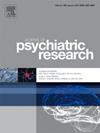过度虑情绪的动态变化表明,失眠会在一夜之间加剧过度虑情绪
IF 3.7
2区 医学
Q1 PSYCHIATRY
引用次数: 0
摘要
过度焦虑是焦虑症、压力相关疾病和失眠症的一个主要症状。然而,人们对过度焦虑的概念有多种不同的理解,从各种生理指标(如皮质醇水平、高频脑电图活动)到人格特质,或主观焦虑和紧张的状态评估,不一而足。这种方法产生了部分不一致的证据,使统一的解释变得复杂。最重要的是,以前的研究没有涉及过度焦虑在日内和日间的可能变化,也没有研究过度焦虑的这种变化与失眠症特有的睡眠质量的逐夜变化之间的关系。在这里,我们提出了一种新颖的数据驱动方法,以了解失眠症中过度焦虑状态的动态变化。通过生态学瞬间评估,我们追踪了 169 名失眠症患者和 38 名无睡眠问题的对照组患者在 9 天内的各种情绪波动。探索性因子分析确定了一个过度焦虑因子,由描述紧张和痛苦的项目组成。在所有时间点上,失眠症患者在该因子上的得分都明显高于对照组。在这两组人中,过度焦虑因子的得分在早晨达到峰值,并在一天中逐渐减弱,这表明睡眠或其他昼夜节律过程可能起到了促进作用。重要的是,与对照组相比,失眠症患者的过度焦虑在一夜之间的增加更为强烈。随后进行的自适应 LASSO 回归分析表明,在主观睡眠质量较差的夜晚,过度焦虑在一夜之间的增加更为强烈。因此,以过度焦虑为主诉的失调症患者可能会受益于以改善睡眠质量为重点的干预措施。本文章由计算机程序翻译,如有差异,请以英文原文为准。
Hyperarousal dynamics reveal an overnight increase boosted by insomnia
Hyperarousal is a key symptom of anxiety, stress-related disorders, and insomnia. However, it has been conceptualized in many different ways, ranging from various physiological markers (e.g. cortisol levels, high-frequency EEG activity) to personality traits, or state assessments of subjective anxiety and tension. This approach resulted in partly inconsistent evidence, complicating unified interpretations. Crucially, no previous studies addressed the likely variability of hyperarousal within and across days, nor the relationship of such variability in hyperarousal with the night-by-night variability in sleep quality characteristic of insomnia.
Here, we present a novel data-driven approach to understanding dynamics of state hyperarousal in insomnia. Using ecological momentary assessment, we tracked fluctuations in a wide range of emotions across 9 days in 169 people with insomnia disorders and 38 controls without sleep problems. Exploratory factor analysis identified a hyperarousal factor, comprised of items describing tension and distress. People with insomnia scored significantly higher on this factor than controls at all timepoints. In both groups, the hyperarousal factor score peaked in the morning and waned throughout the day, pointing to a potential contributing role of sleep or other circadian processes. Importantly, the overnight increase in hyperarousal was stronger in people with in insomnia than in controls. Subsequent adaptive LASSO regression analysis revealed a stronger overnight increase in hyperarousal across nights of worse subjective sleep quality.
These findings demonstrate the relationship between subjective sleep quality and overnight modulations of hyperarousal. Disorders in which hyperarousal is a predominant complaint might therefore benefit from interventions focused on improving sleep quality.
求助全文
通过发布文献求助,成功后即可免费获取论文全文。
去求助
来源期刊

Journal of psychiatric research
医学-精神病学
CiteScore
7.30
自引率
2.10%
发文量
622
审稿时长
130 days
期刊介绍:
Founded in 1961 to report on the latest work in psychiatry and cognate disciplines, the Journal of Psychiatric Research is dedicated to innovative and timely studies of four important areas of research:
(1) clinical studies of all disciplines relating to psychiatric illness, as well as normal human behaviour, including biochemical, physiological, genetic, environmental, social, psychological and epidemiological factors;
(2) basic studies pertaining to psychiatry in such fields as neuropsychopharmacology, neuroendocrinology, electrophysiology, genetics, experimental psychology and epidemiology;
(3) the growing application of clinical laboratory techniques in psychiatry, including imagery and spectroscopy of the brain, molecular biology and computer sciences;
 求助内容:
求助内容: 应助结果提醒方式:
应助结果提醒方式:


